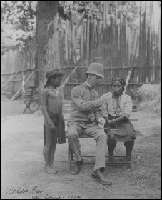|
|
|
監督・脚本・撮影・編集・製作:マーロン・フュエンテス
Director, Script, Photography, Editing, Producer : Marlon Fuentes |
フィリピン生まれの映画作家、写真家、コンセプチュアル・アーティスト。マニラのデ・ラ・サール大学に通ったのち、ペンシルヴァニア大学とテンプル大学の映画・ビデオ課程で卒業制作を行う。作品は最近15年間で、60以上もの展覧会で展示され、スミソニアン博物館やその他の全米の有名な芸術機関にも収められている。写真家としてのある到達点から、映画作家となってからの彼の作品は、さらに未踏の領域を切り開きつつ、進展し続けている。『Sleep With Open Eyes』は「自叙的な忘我状態映画」であり、他の作品に『Tantalus』『Arm』『Crikee』などがある。 Philippine-born filmmaker, photographer, and conceptual artist. After attending De La Salle University in Manila, he did his graduate work at the University of Pennsylvania and Temple University's Film and Video program. His work has been shown in over sixty exhibitions over the last 15 years. It is represented in the Smithsonian Institution's National Museum of American Art and other prestigious art institutions around the U.S. As filmmaker, his work follows new terrain uncovered by his previous investigations in photography. Sleep With Open Eyes is an " autobio-graphical trance film. " Other works include Tantalus, Arm, and Crikee. |
 |
|
| フィリピン人監督によるこの作品は文化と民族の尊厳を新しい文体で探究している。現代のアメリカに住む監督と1904年の万博で「生きた標本」としてアメリカに連れて来られたボントク族の勇者が重なり、差別と権力構造の仕組みを考えるきっかけとなる。歴史映像、記憶、想像を織りまぜた力作だ。 | Fusing history, memory, and imagination, Bontoc Eulogy explores the complex psychological territory of the Filipino experience at the St. Louis World's Fair of 1904. Experiences of the filmmaker, a Filipino immigrant in America, and the Igorot warrior held captive on show as one of the " primitive men " overlap with each other, stimulating a discourse on power and discrimination. |
|
|
|
|
監督のことば 植民地時代そして植民地時代後のフィリピンの近現代史は、「正史」の不在により、常に自己の歴史を再定義する試みの歴史である。1904年のセントルイス世界博覧会は決定的な歴史の転換点だった(すなわち、スペイン植民地時代の終焉、米西戦争の終結、アメリカのフィリピン領有公式宣言)。それまでは潜在的なものであった様々な植民地主義的政策が、組織化され、かつてない規模で一気に顕在化したのだ。この博覧会は、進歩と開明化という時代主潮のなか、壮大な混合主義の光景であったし、「他者」であることを徹底したうえでの「生けるジオラマ(風景標本)」であった。そこでは、「見世物」が「イデオロギー」と「科学」とに結び付き、野蛮なボントク・イゴロト族から文明社会に「同化」できる低地タガログ人まで、標本として集められたフィリピンの各民族が、「帝国」の構築に不可避な事業のために徴用され、その「生きた素材」として陳列されていた。 我々が期待することと実際に見たものが予想外に相反するとき、我々は自分自身のものの見方に対して自覚的になりうる場合がある。『ボントク頌歌』で私は、歴史と想像力の間で、民族誌的な郷愁感に覆われた外面とそれをブレヒト的に異化する試みの間で、そして幻想と反-幻想の間での「揺れ」を前面に描こうとした。 |
Director's Statement The history of the Philippines, a colonial and post-colonial subject, is by default a history of a continuous attempt at self-definition. The 1904 St. Louis World's Fair is a critical historical juncture (i.e, the end of the Spanish colonial era, the end of the Philippine American War, the formal enunciation of American Manifest Destiny on the Filipino subject) where the underlying grid of colonial politics becomes visible on a scale never seen before. It was the sublime syncretic landscape, a living diorama that played out the Other's role in a master narrative of Progress and Civilization. Here, spectacle meets ideology and science: from savage Bontoc Igorot to " assimilatable " Tagalog lowlander, the Philippine specimen was displayed as malleable raw material for the inevitable project of Empire. The unexpected conflict between what we expect and what we see can sometimes bring us back to the consciousness of our own act of perceiving. In Bontoc Eulogy, I want to foreground the oscillation between history and imagination, between the patina of ethnographic nostalgia and the Brechtian disruptions to this surface, between illusion and anti-illusion. |
